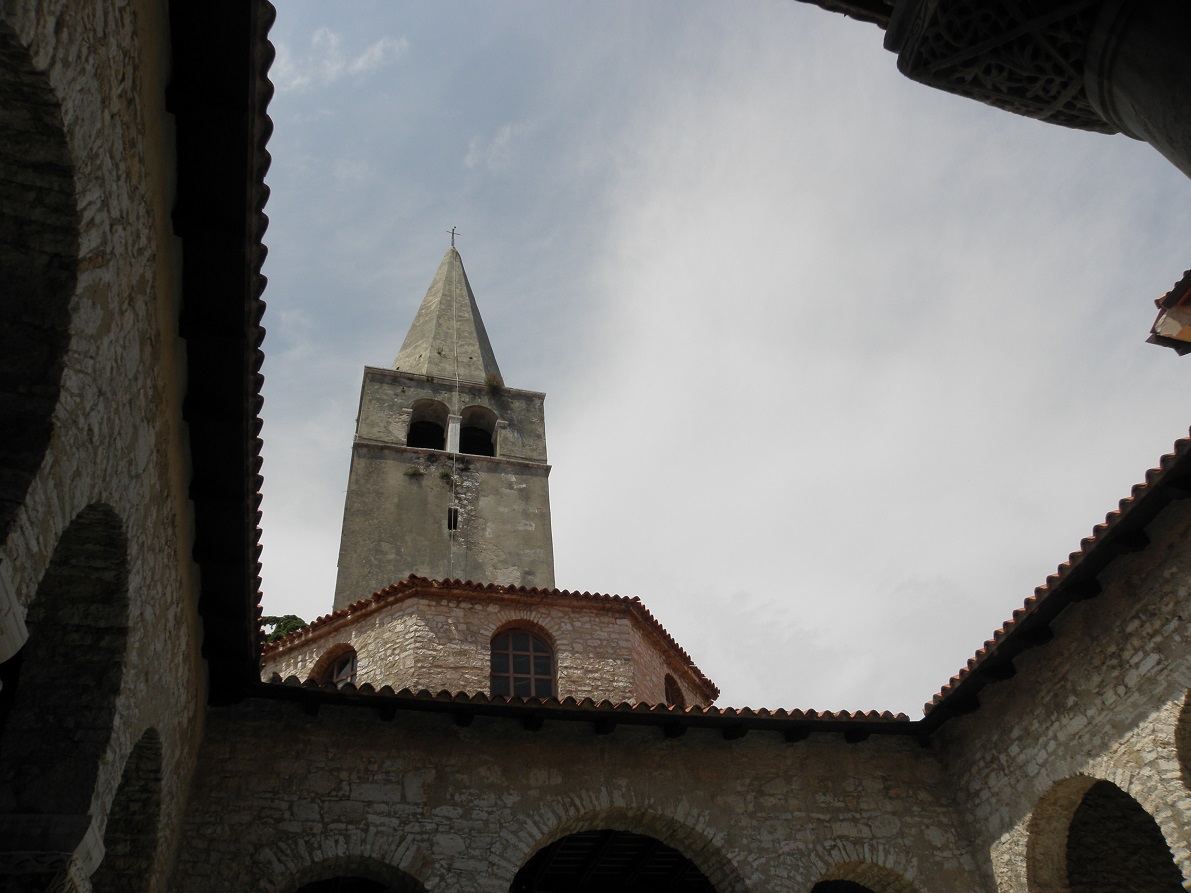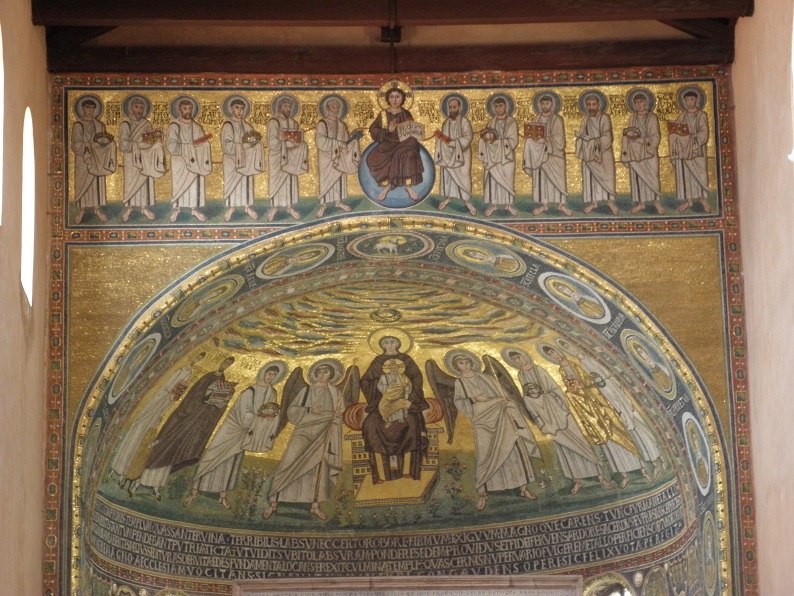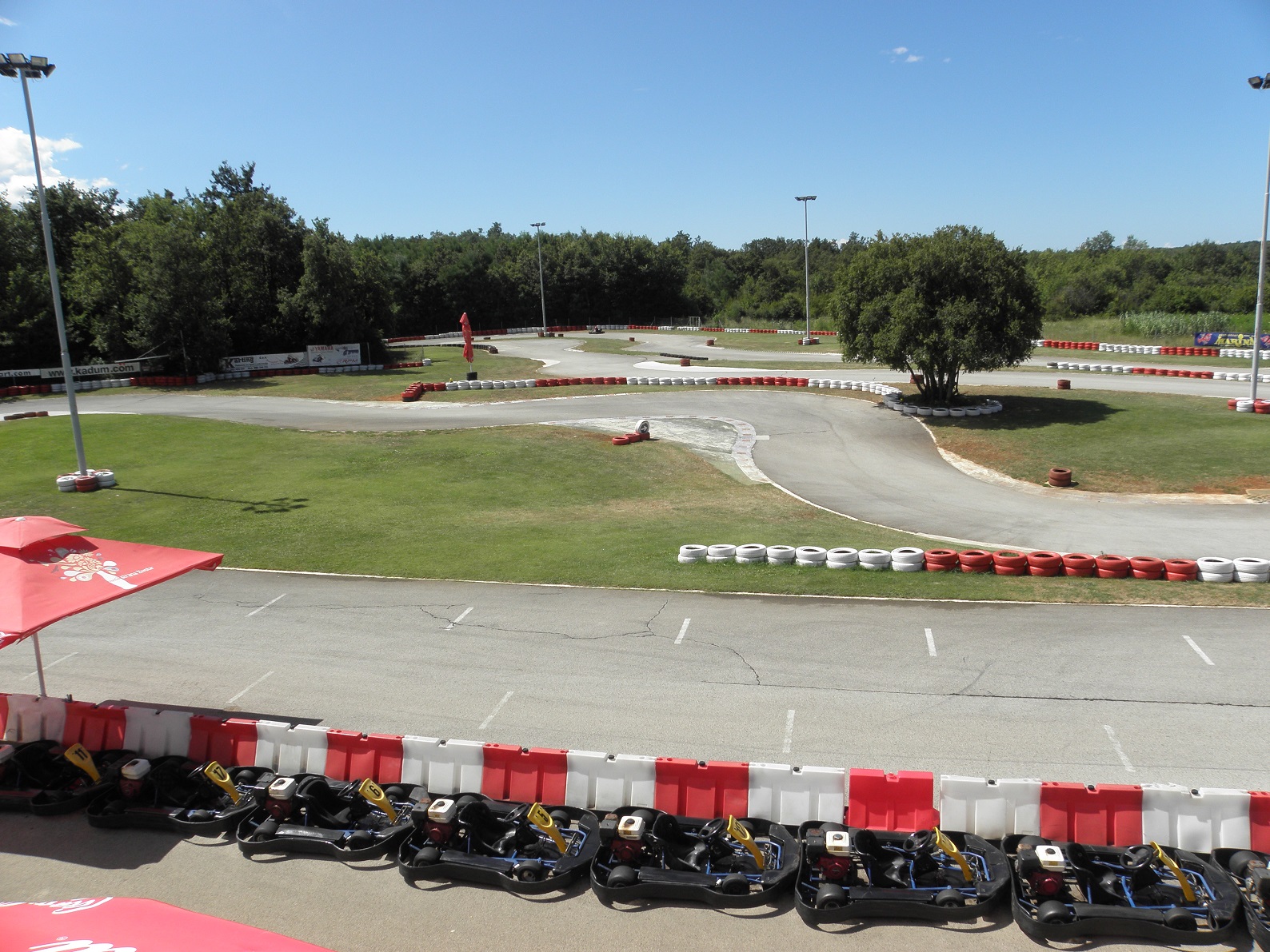Poreč Hosts Seven Days of Protected Croatian Prosciutto!
June 10th, 2021 - An exhibition and sales event on the Poreč waterfront, a new champion, awards ceremony, professional workshops, and the largest number of protected Croatian prosciutto producers yet - the largest event dedicated to the famous delicacy has been announced!
We will find out soon who has the best prosciutto in Croatia this year. If you are a fan of this delicacy and beautiful Istria, book June 18th and 19th because this year Poreč is the host of the largest event dedicated to protected Croatian prosciutto. There are already four areas with EU protection - Krk, Drniš, and Dalmatia with the protected geographical origin, and Istrian with protected original origin. One of them will take the championship title.
Istrians and their guests will be able to taste the best prosciutto on the second day of the event, June 19, on the Poreč waterfront. From 8 am to 5 pm, producers will sell all four protected prosciuttos at promotional prices. They will be joined by producers of cheese and IQ Malvasia and Teran organized by Vinistra.
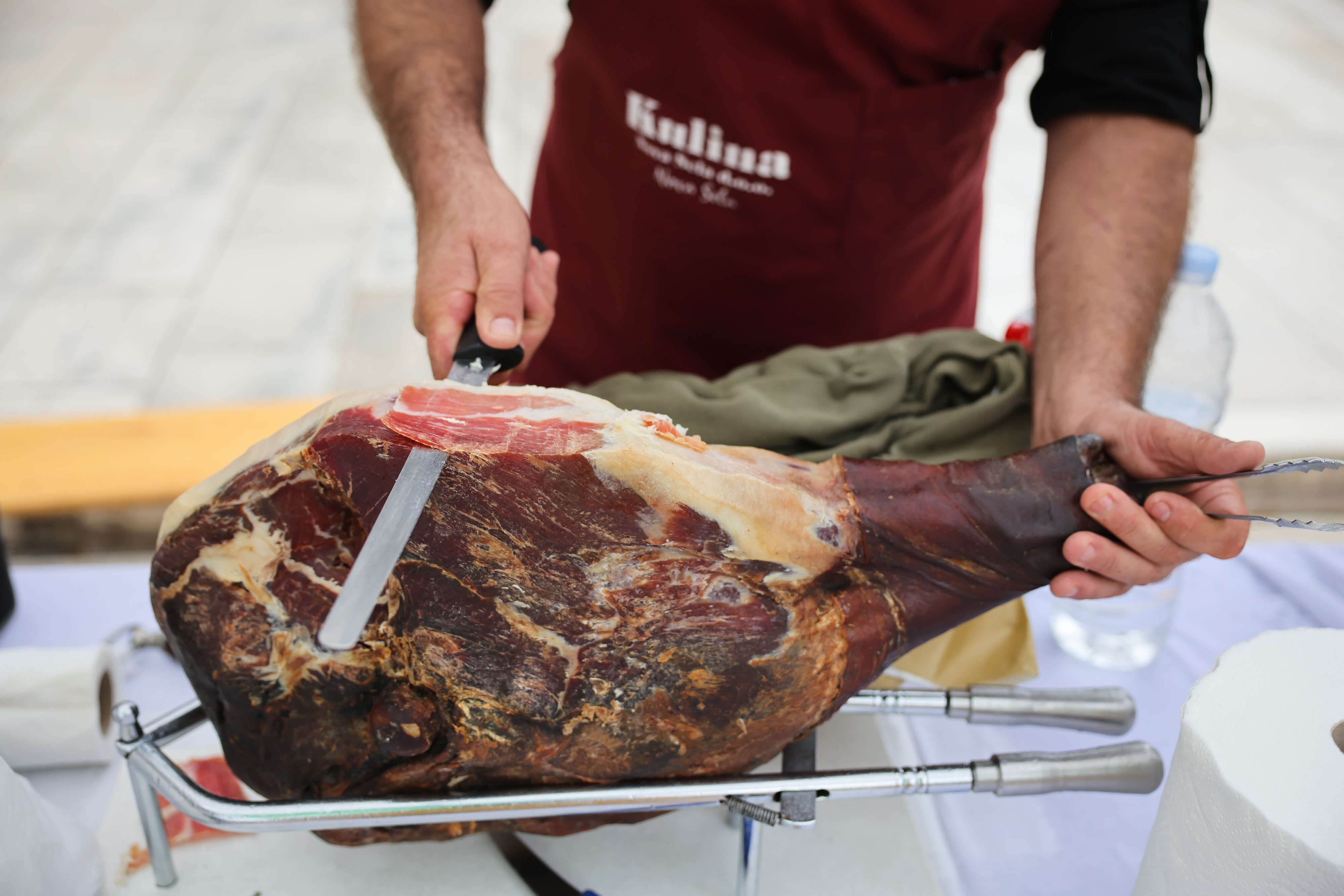
Filip Brala (archive 2020.)
The Days of Croatian Prosciutto have been promoting one of the most sought-after Croatian delicacies for seven years, confirmed by the figures. Namely, on the domestic market, we eat twice as much prosciutto per year as we produce. The ratio is 450 thousand to one million pieces, while we import more than 400 thousand pieces.
Although we ate slightly less prosciutto during the pandemic, producers say that sales have fallen by an average of thirty percent, the potential for production growth is huge. By easing epidemiological measures, everything could go back to normal. However, while the participants and visitors of the Croatian Prosciutto Day are still in force, they will have to adhere to them, according to the Croatian Prosciutto Cluster, the organizer of the event.
This year's event is held under the auspices of Zoran Milanovic, President of the Republic of Croatia, Ministry of Agriculture, Ministry of Tourism and Sports, Croatian Chamber of Commerce, Istria County, City of Porec, Tourist Board of Porec, and the City of Zagreb.
For more, follow Made in Croatia.
To find out more about Poreč, CLICK HERE.
Porec Parklets to Secure More Space for Pedestrians and Socializing
April 23, 2021 – By implementing the EU project Living Streets, Porec parklets will soon be placed on Zagrebačka Street and provide its citizens with small green oases.
A little more than half a year ago, we reported that the City of Poreč is preparing an exciting project named Living streets, revitalizing the streets of European cities, namely turning them into "living rooms," or green oases for relaxation. With the approved funds from the European Union, this project is finally starting to be realized in this Istrian town.
With the successful application of another "green" city project within the EU project EUKI (European Climate Initiative), the City of Poreč-Parenzo got a little more than 150,000.00 kunas in grants for the implementation of the Living streets project.
As part of the project, and to increase green areas, the streets of Poreč will get a new look – the so-called parklets. Parklet means an improvised green area that extends from the sidewalk to the pavement and thus occupies several parking spaces and creates more space for people, inviting them to socialize or representing a public space accessible to all. In this way, urban areas are ennobled and given back their original purpose – to serve the citizens.
In cooperation with citizens, the project aims to point out the importance of public space in urban areas. Thus, Poreč will be revitalized by systematic and long-term micro-transformations of city streets and spaces often congested with traffic and cars, especially during the summer months.
This project also seeks to reduce the use of personal vehicles, which would directly impact reducing the negative effects on human health. Also, emissions of both greenhouse and other gases would be reduced, which will significantly impact the quality of life in Poreč.
The project team has chosen Zagrebačka Street as the location of the future parklet. Besides the City, the project partners are the city company Parentium and the association Zona for improving the quality of life.

Photo: the City of Poreč-Parenzo
Source: the City of Poreč-Parenzo
To read more about this Istrian town, check our Total Croatia guide for Poreč.
For more about lifestyle in Croatia, follow TCN's dedicated page.
People Also Ask Google: How Far is Porec from Other Parts of Croatia?
March 2, 2021 – You've found yourself in Croatia, you've heard about Porec being an exciting town in Istria, and now you want to seize the opportunity to visit it? In our People Also Ask Google series, we explain how far is Porec from other parts of Croatia.
Although beautiful in all areas, Croatia is a country with an extremely unusual shape, making it difficult to travel from one part to another (for example, from Osijek to Dubrovnik). The long and very indented coast on the Adriatic Sea hides some of the most beautiful seascapes. Due to its specific position and numerous bays and islands, it is impossible to explore it in one fell swoop.
The largest peninsula in Croatia – Istria – is located in the north of the Croatian Adriatic coast and hides many natural and cultural sights in the west part of Croatia, where also lays Croatia's westernmost point – Savudrija. If in Croatia, it would be a shame if one does not take the opportunity and visit Istria. Cities on the west coast of Istria, such as Rovinj, Poreč, and Pula, have been attracting tourists' attention for years because of their proximity and excellent connections with Central Europe and its irresistible cultural heritage that makes them interesting destinations worth exploring.
We recently described whether Porec is worth visiting, and in this article, we will try to explain how far Porec is from other parts of Croatia and how to reach this one of the many Istrian gems easily.
However, if you are interested in how to get to Istria from Italy or Slovenia by car, bus, train, plane, or ferry, you can find all the information in the TCN's special guide.
How far is Porec from the airport?
Pula Airport – If coming by plane to Croatia, Pula Airport is the closest to Poreč. The distance between Pula Airport and Poreč is about 58 kilometers, of which 42 kilometers is the Istrian highway (i.e., the Istrian Y). The bus drive from Pula Airport to Poreč takes an hour, while the car ride takes 45 minutes. However, you can also take the local road through Istria. Still, even though it is a slightly shorter distance (52 kilometers), your journey will take at least 15 minutes longer in ideal conditions. Before you choose a route, consider that local roads in Istria can be very crowded during the summer season.
There are shuttle bus lines from Pula Airport to the main Pula bus station, 30 minutes after the landing of the aircraft, from where you can take a bus to Poreč (as well as to other parts of Istria). The shuttlebus drive to Pula takes 10-15 minutes, and the ticket costs 30 kunas. You can check the Pula Airport shuttlebus schedule for 2021, as well as other shuttle bus services from Pula Airport.
From the main Pula bus station, you can easily take the bus to Poreč with services provided by Arriva, Flixbus, and others. The bus connection between Pula and Poreč is excellent, with many bus lines throughout the year and day, especially during the summer season.
If you decide to take a car ride from Pula Airport to Poreč, several rent-a-car businesses offer services at Pula Airport.
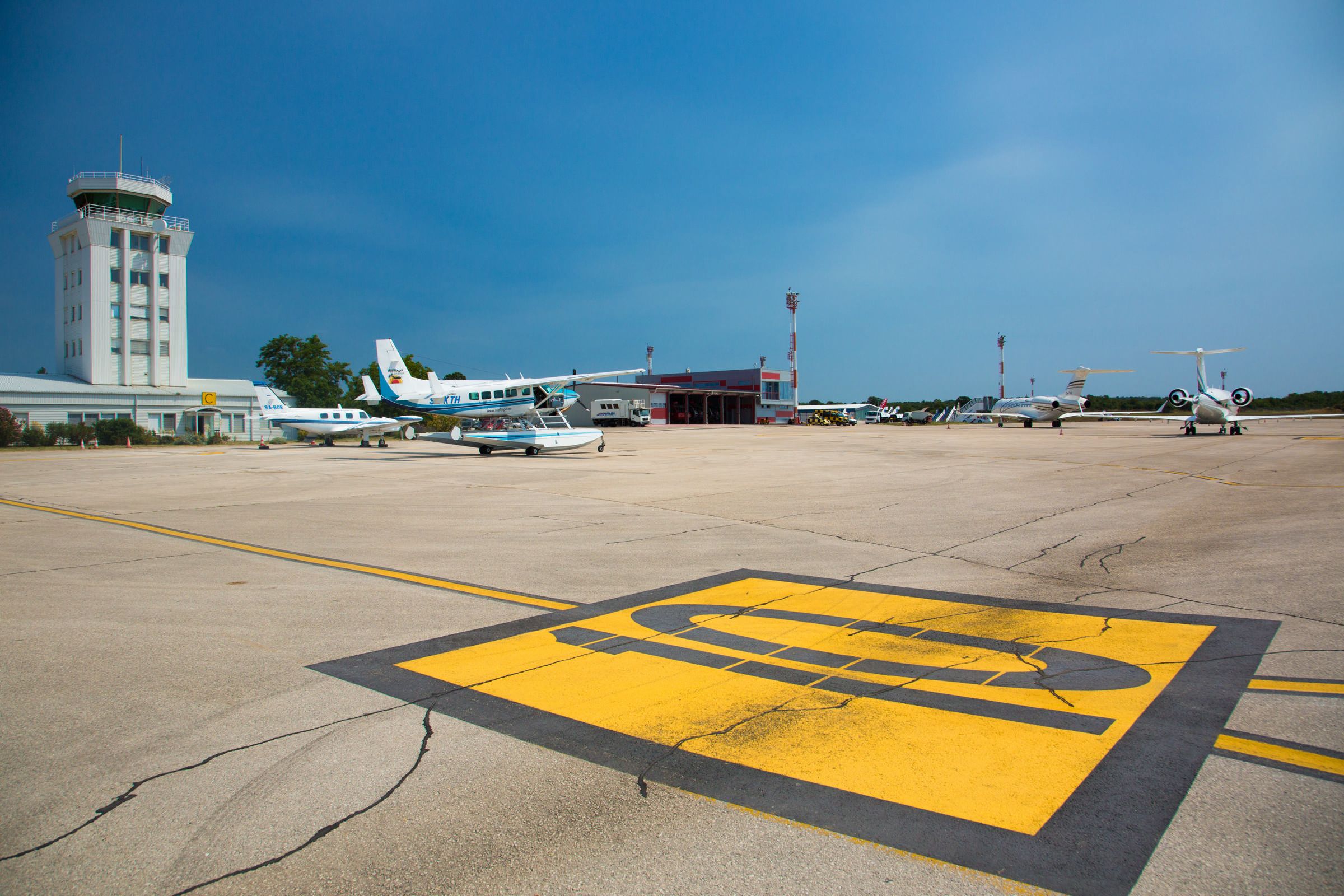
Pula Airport / Romulić and Stojčić
If you choose to take the local road to Poreč, you should follow the local D21 road, as seen on the photo below, and the journey will take about an hour.
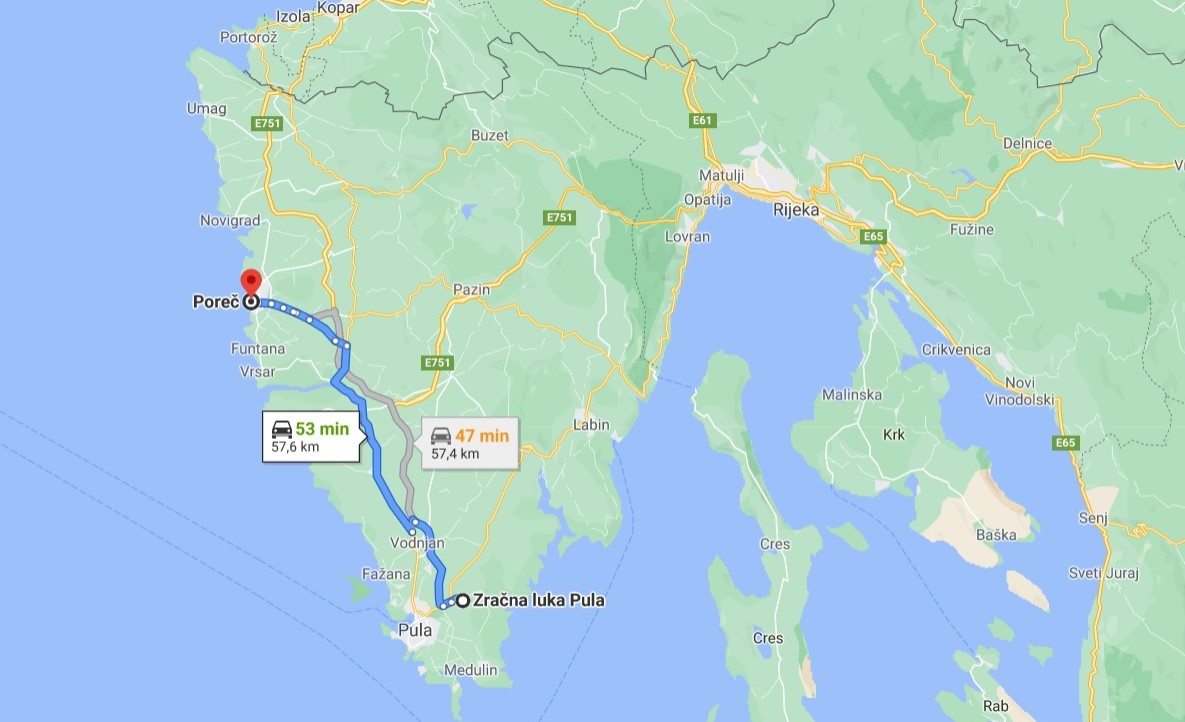
However, if you're taking the highway, you enter the E751 highway (A9 in Croatian) Istrian Y highway, at the Pula junction, and then get off at the Baderna junction. Note: A toll is charged on this route and costs 27 kunas for the first vehicle category. (Check all prices on Istrian Y here.) From Baderna, Poreč is only 17 minutes away by the local road. This route is showed on the photo below.
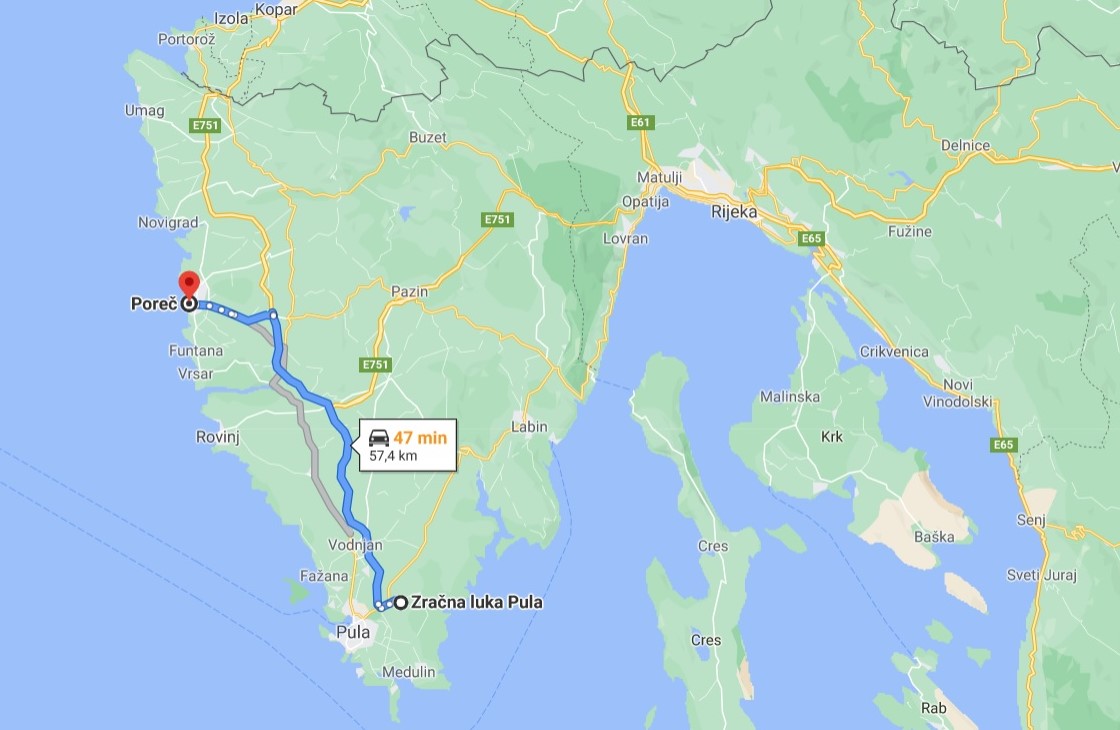
Check more cheap and quick ways to get from Pula Airport to Poreč here.
Rijeka Airport – The second closest Croatian airport to Poreč is Rijeka Airport, situated on the island of Krk, which is connected with the Croatian land by bridge. It is located about 30 kilometers from the center of Rijeka. Just like at the Pula Airport, the Rijeka Airport also offers shuttle bus services to the Rijeka city center, shortly after arrival of airplanes. However, during winter months, there's no regular shuttle service, but only service on demand from/to Rijeka and Omišalj on Krk. From Rijeka, you can take a bus to Poreč, and you can find more details about that route later in the article.
If you are traveling from Rijeka Airport to Poreč by car, you can rent a car at the Rijeka Airport, from where you'll get to Poreč in an hour and 45 minutes. The car route from Rijeka Airport to Poreč is about 115 kilometers, of which 75 kilometers is the highway (Istrian Y), and this is shown on the photo below. Find more info about Poreč to Rijeka by car later in the article.
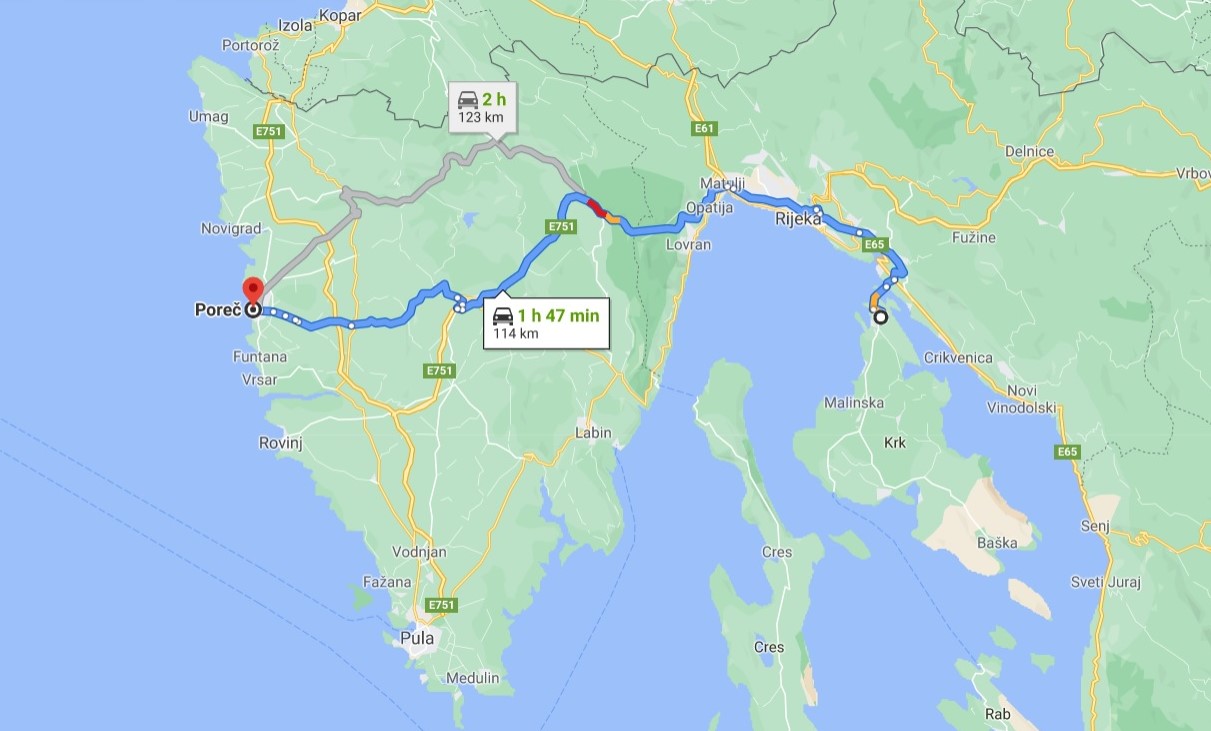
Check more cheap and quick ways to get from Rijeka Airport to Poreč here.
Other nearer airports to Poreč are Zagreb Airport, Ljubljana Airport, Trieste Airport, Treviso Airport and Venice Airport.
How far is Porec from Rijeka?
Poreč is 102 kilometers from Rijeka, and it takes an hour and 25 minutes of driving along the Istrian Y highway and local road by car. Of course, the traffic conditions should be taken into account, because during the season, the traffic can be increased which prolongs the time of traveling.
To go from Rijeka to Poreč by car, you can take the Istrian Y highway from Matulji near Rijeka and exit it in Rogovići near Pazin, from where you must continue to Poreč along the local road. Note: A toll is charged on the route from Rijeka to Pazin and costs 37 kunas for the first vehicle category. However, if you do not fancy paying a highway toll, and you'd like to stop at the Učka National Park along the way, you can take a local road D48 or D44 local road bypassing the Istrian towns of Buzet and Motovun. If you want to go along the eastern Istrian coast, you can take the local road number D66 to get from Rijeka to Poreč.
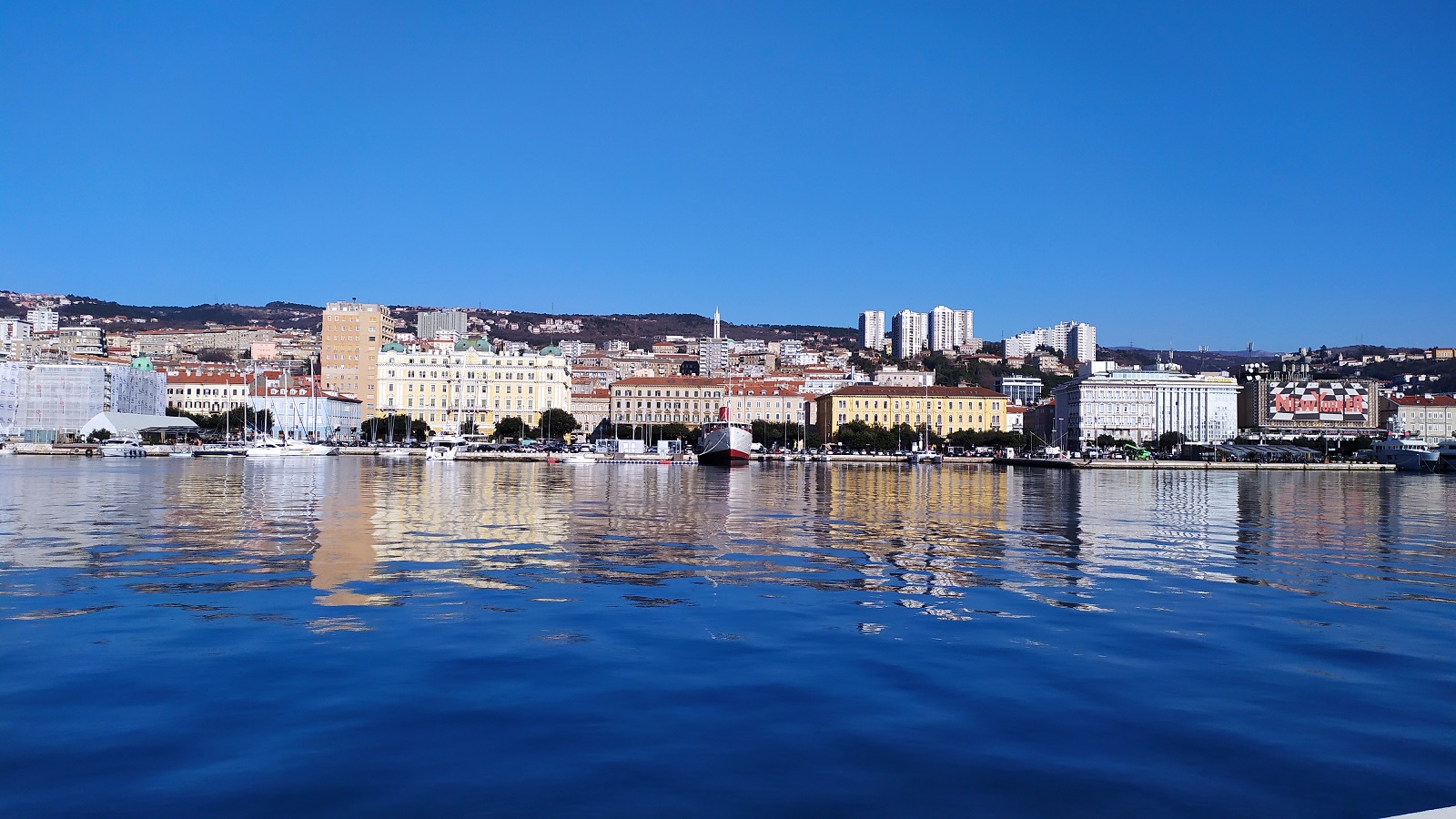
Rijeka / Donatella Pauković
Suppose you decide to take a bus from Rijeka to Poreč. In that case, there are several daily bus lines provided by Arriva, Flixbus, and other Croatian bus operators throughout the year and day. During the summer tourist season, the bus lines from Rijeka to Poreč are more frequent. It takes about an hour and a half from Rijeka to Poreč by bus, depending on the traffic conditions.
How far is Porec from Rovinj?
Poreč is 42 kilometers away from Rovinj, and you can quickly get there by bus in 45 minutes, and even faster by car. During the high summer season, there can be more traffic, so traveling time can vary. Since these two Istrian towns are so close, there are also boat lines connecting them.
Ferry from Rovinj to Poreč served by TriesteLines runs twice per week in the high summer season but does not operate outside the season. The journey takes 30 minutes and is only a foot-passenger ferry. Neither pets nor bikes are permitted onboard. Due to the coronavirus pandemic, there are likely to be many alternations and cancellations of the ferry schedules, so you will have to double-check all information. The TriesteLines operates daytime connections exclusively during summer, from Trieste to and between the port of Piran in Slovenia and the ports of Poreč, Rovinj, and Pula in Croatia.
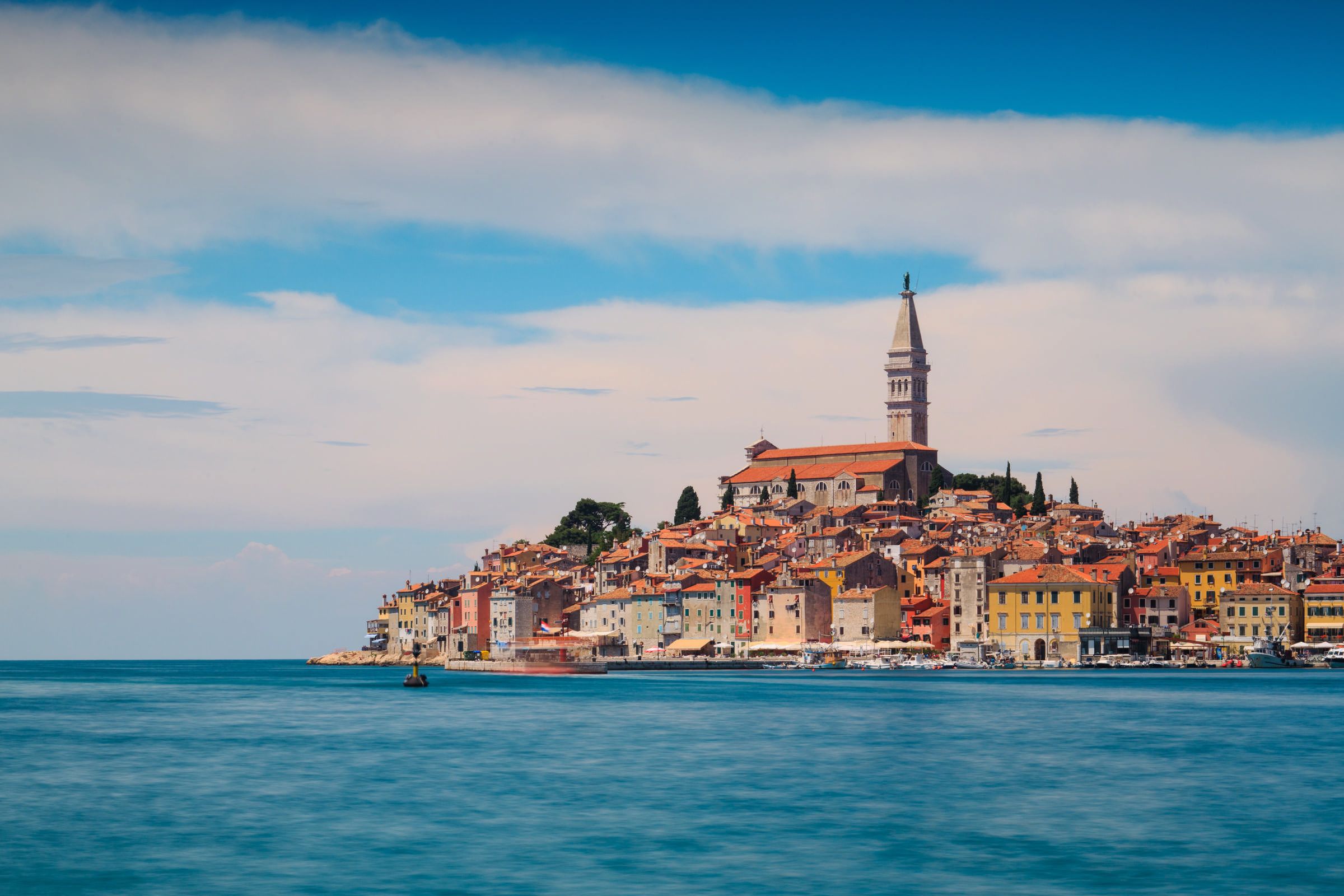
Rovinj / Romulić and Stojčić
If visiting only one town, you can easily book a one-day trip to another city. Poreč and Rovinj are separated by the Lim Bay (Lim Fjord), created as a rias of the river Pazinčica which in the past flowed into the Adriatic Sea, which today sinks in the Pazin Cave near Pazin. Hence, the road is enjoyable whether you ride a boat or car.
Several bus lines are running between Rovinj and Poreč every day, and during the summer season, there are even more of them. Bus lines from Rovinj to Poreč and in the opposite direction can be found here. You can also take the taxi from Rovinj to Poreč or find other transfer options.
How far is Porec from Dubrovnik?
Considering the fact that Dubrovnik, due to its separation and distance in the southernmost part of Croatia, is one of the hardest cities to reach in Croatia, it is quite far away from other parts of Croatia outside Dalmatia, including from Poreč. Since Poreč is 691 kilometers away from Dubrovnik, there are no direct bus lines between the two cities, but the alternative travel option would be through Rijeka. There are several bus lines operating from Dubrovnik to Rijeka, and Rijeka and Poreč are very well connected with bus lines, as explained earlier in the article.
A few bus lines from Dubrovnik to Rijeka operate throughout the year, while during the summer season, there are even more of them. The journey takes about 12 hours.
If you decide to take a car ride from Dubrovnik to Poreč, it will take about 7 hours and 50 minutes of traveling. For more details about crossing the Croatian-Bosnian border near the Bosnian town of Neum, check our dedicated article. From Dubrovnik, you can drive along the Croatian coast, i.e., the Jadranska Magistrala (D8 state road), and connect to the E71/E65 highway (A1 in Croatian) all the way to the junction Žuta Lokva in Lika (and pay a toll). From there, you can again take a local road and Jadranska Magistrala to Rijeka, where you can connect to the Istrian Y highway (as explained earlier in the article).
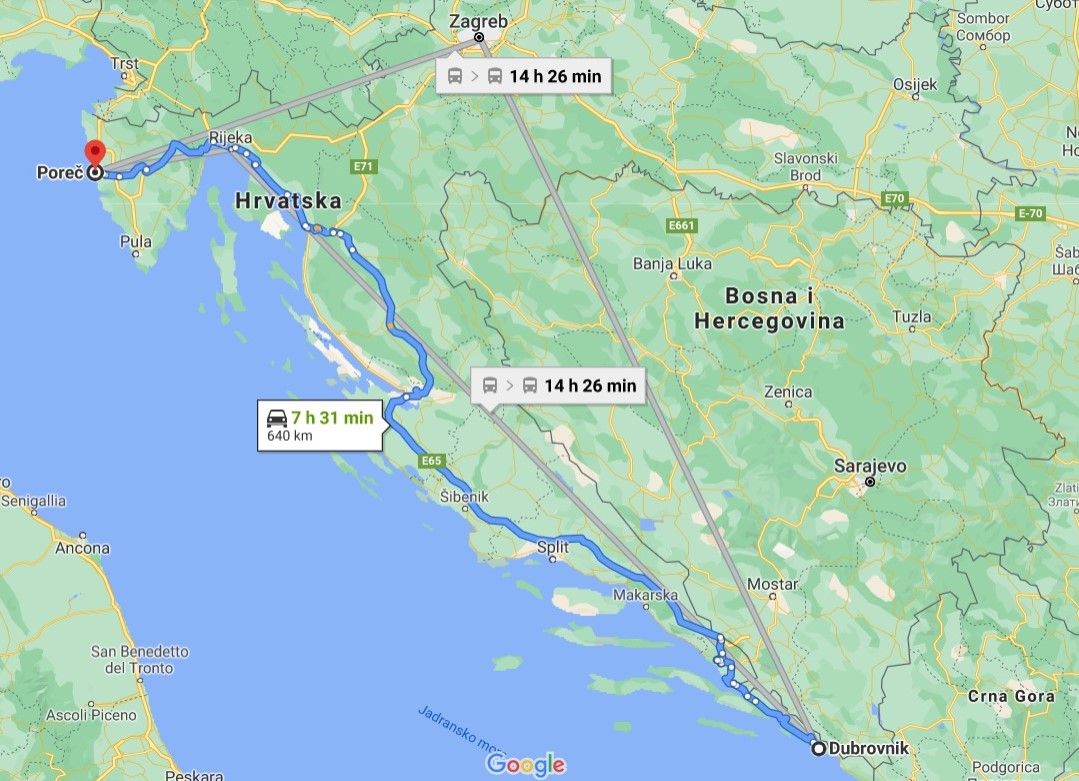
There are no ferry lines between Dubrovnik and Poreč either, nor between Dubrovnik and Rijeka.
How far is Porec from Split?
The distance between Split and Poreč is 451 kilometers, and just like with Dubrovnik, there are no bus lines connecting these two Croatian cities. Also, Poreč can be reached from Split by bus lines through Rijeka, as well as by car and highway.
How far is Porec from Zagreb?
Poreč is 250 kilometers away from Zagreb, and you can quickly get there by numerous bus lines throughout the year, as well as by a personal vehicle. If coming from the continental Croatia, Istria and Kvarner are the closest seaside destinations and easiest to reach.
How far is Porec from Osijek?
As with Zagreb, Poreč is also well connected with Osijek by bus lines operating throughout the year. Poreč is 530 kilometers away from Osijek, and it takes five and a half hours to get there by car. Some bus lines going from continental Croatia to Poreč stop in other smaller Croatian towns, such as Novska, for example, providing connected lines to Poreč. Check all bus lines to Poreč with Flixbus, Arriva, and other Croatian bus lines.
If you'd like to know the exact distances between cities in Croatia, you can check them all at one place (in Croatian).
To follow the People Also Ask Google about Croatia series, click here.
People Also Ask Google: Is Porec in Croatia Worth Visiting?
February 21, 2021 – Continuing the TCN series answering the questions posed by Google's People Also Ask function. Is Porec in Croatia worth visiting? The shortest answer would be – of course – and here are all the reasons why.
What is Porec like in Croatia?
Located on the west coast of the Istrian peninsula in Croatia, Poreč can most simply be described as a seaside town with many tourist attractions but also with a rich and indispensable cultural history. It is perhaps best known as the home of the Euphrasian Basilica (so-called Euphrasiana) from the 6th century, one of the seven UNESCO's world heritage sites in Croatia.
However, in the last few years, Poreč has been filling newspaper columns as one of the best cities to live in Croatia, which has been contributed to by its economic, cultural, and social development. A famous tourist town that lives throughout the year? It seems like it could be. Since I have been spending almost every summer in Poreč since I was born, I would unquestionably like to get to know it better from the perspective of living in it. Maybe one day, but for now, I will focus on what I know Poreč is worth visiting for.
Historic center: Is Porec in Croatia worth visiting for culture and heritage?
Apart from the aforementioned Euphrasian Basilica, a must-see cultural site to visit, the whole old Poreč city core is a cultural monument. The peninsula on which the old town of Poreč is located hides historic traces dating back thousands of years. The main street that passes through it – Decumanus – is full of tourists in summer due to its numerous shops and restaurants. At the intersection with Cardo Street, the so-called Dekumanova Street reveals several Gothic and Baroque palaces.

The Euphrasian Basilica in Poreč is one of the most beautiful preserved monuments of early Byzantine art in the Mediterranean.
Built in the 6th century during Bishop Euphrasius, after whom it is named, the Euphrasian Basilica is famous for glittering mosaics dating from the 3rd century. The picture shows the Euphrasian Basilica's apse decorated with Byzantine mosaics.
At the entrance to Dekumanova Street from Sloboda Square, attention is drawn to the Pentagonal Tower, at the top of which is a restaurant. At the top of the nearby Round Tower overlooking the waterfront, tourists love to enjoy a cafe.
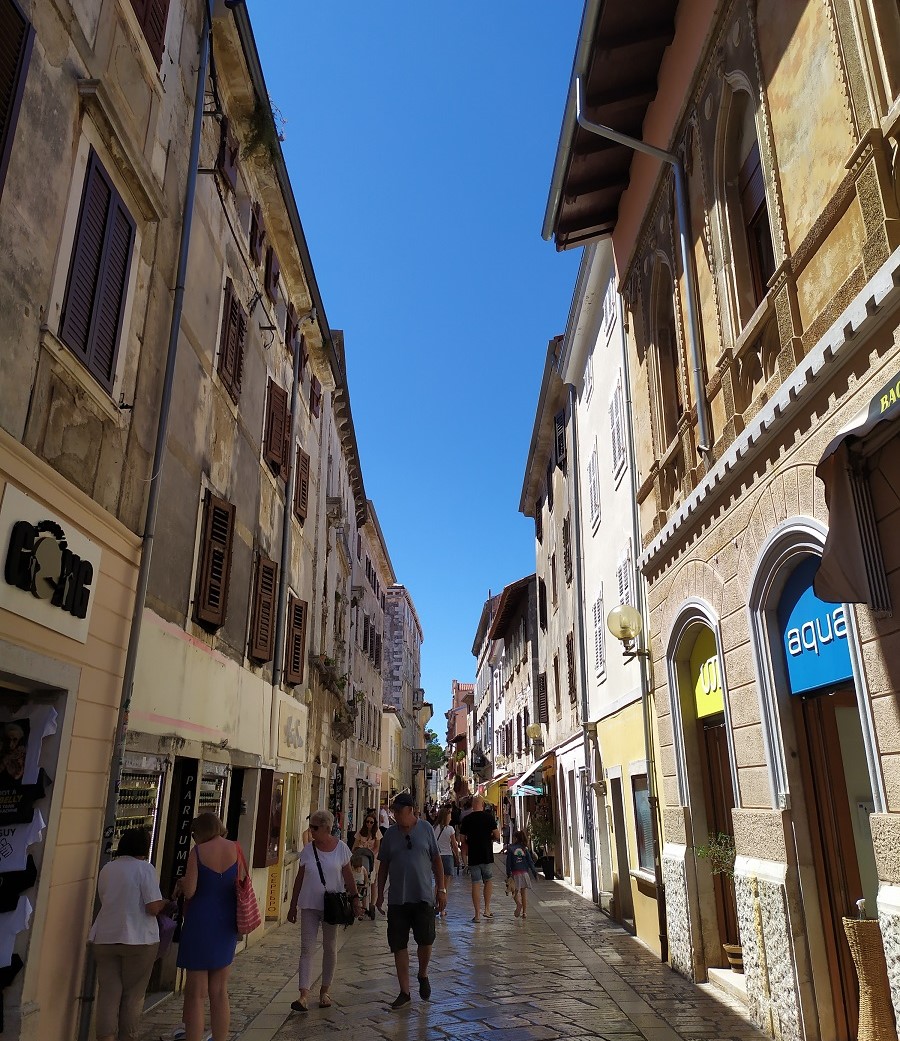
Dekumanova Street / Decumanus Street in Poreč
Evidence of life from ancient times is hidden near the oldest square of Marafor. Also, Poreč is the proud home of the largest Roman shrine in Istria, the Large Temple, and to the north of it are the remains of the Temple of Neptune.
For me, one of the usual evening activities in Poreč is a walk through the old town in the mentioned Decumanus Street, as well as along Poreč's lungomare or Ante Šonja Coast, with a romantic view of the north side of Poreč – Peškera Bay (where the city beach is located), Pical, and Materada. I call it the quiet side because there are no stands on it, for which the other part of the city is famous, just the open sea in front of you, with some lighthouse flashes.
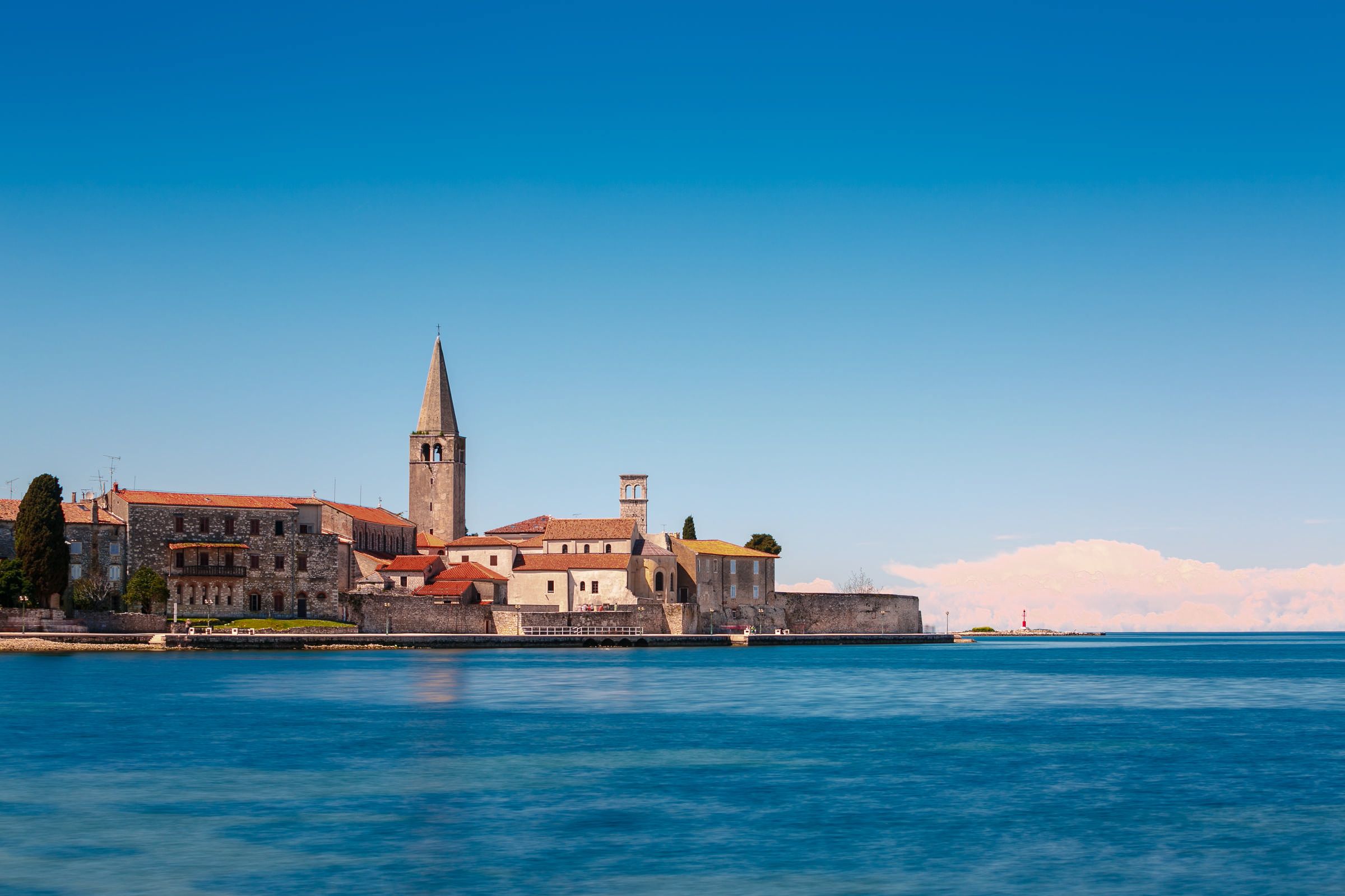
The old town of Poreč and Poreč lungomare / Romulić and Stojčić
I usually continue my walk along the coast to the newly renovated city waterfront, i.e., Marshal Tito's Coast, thus embracing the entire old core of Poreč. I admire numerous yachts, tourist boats, and fishing boats moored in the Poreč port along the waterfront side.
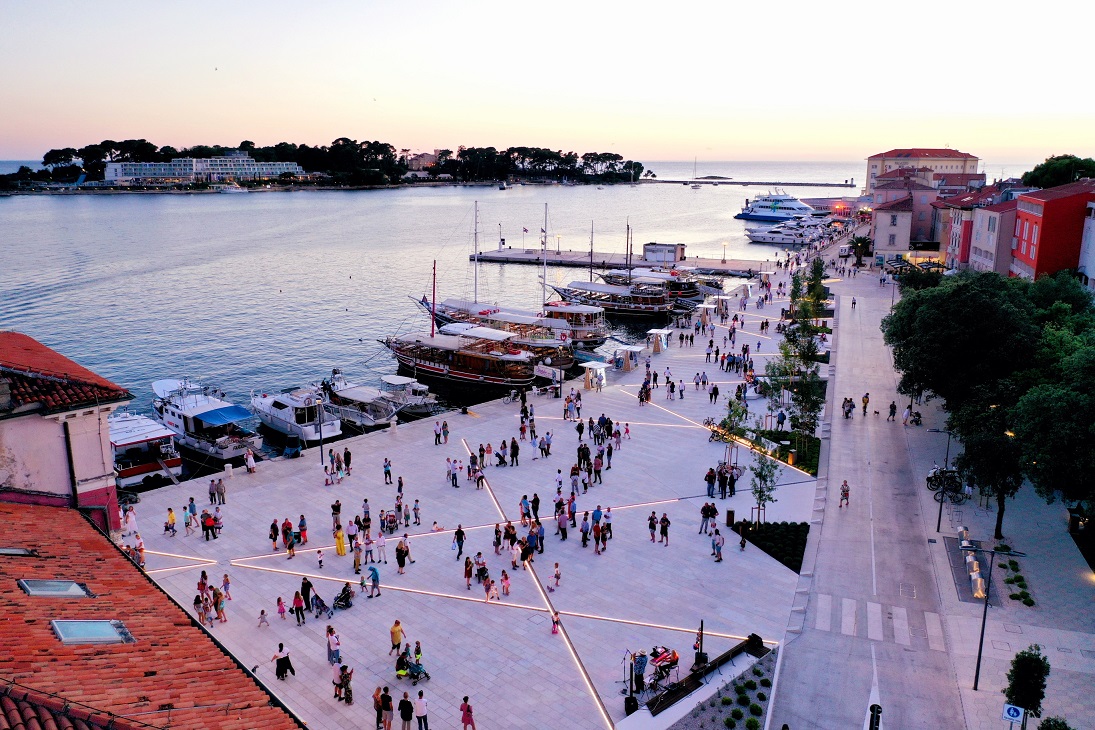
Last year, the Poreč waterfront, an integral part of the Poreč old town, got a new attire – new facilities with signposts to the old town's sights. / Poreč Tourist Board
Is Porec in Croatia worth visiting for beaches and sports activities?
I stayed in Poreč during all stages of my life – from a playful child, through a demanding teenager, to a serious student – and at no time was I bored in Poreč, nor my parents who have been spending their summers in this beautiful Istrian city for almost 30 years. As we are a family that likes a combination of active and lazy holidays, we love Poreč because we get both there – beautiful and clean beaches, as well as many cultural, gourmet, adventure, fun, and sports facilities.
As my all-time favorite activity is rollerblading (and as I'm not a fan of swimming), I enjoy long rides from the center of Poreč along beaches trails. There is a crystal clear sea on one side of the trail, while on the other side, there are various sports and catering facilities. The first beach to reach is Beach Brulo. Located in the mild Mediterranean and sheltered bay, surrounded by pine trees, it is ideal for a real summer vacation.

Brulo Beach / Croatian Tourist Board
The trail along the coast goes all the way to Poreč Blue Lagoon, Green Lagoon, and White Bay, beautiful bays and hotel resorts. I recommend the popular tourist train that goes from the south side of Poreč Riviera! Also, If you like cycling and similar recreation, you will love cycling in Poreč.
As there are pebble, sandy, rocky, and concrete beaches, you will indeed find a beach tailored to your needs in Poreč. In 37 kilometers of the Poreč shore, there are as many as 22 beaches with a Blue Flag, an international symbol of clean sea and landscaped coastline. That is as many as 20 percent of all Blue Flags which flutter along the Croatian coast!
What I always liked about beaches in Poreč are numerous fun activities, such as water sports – pedal boats, canoes, paragliding, banana boats, parasailing, aquapark, and sports facilities such as tennis courts, volleyball courts, and mini-golf.
It is important to emphasize that the City of Poreč works tirelessly to provide access to all cultural facilities to people with disabilities. For example, last year, they carried out an adaptation project in the Euphrasian Basilica, and many beaches have been adapted for people with disabilities.
Our all-time favorite daily activity is visiting the Saint Nicholas island across Poreč, also known as Valamar Isabella Island Resort. In the summer months, the island is connected to the Poreč waterfront by a full-day ferry line. The boat from Poreč to the island goes every thirty minutes in both ways. The boat ride takes only five minutes, and the ticket price is 40 kunas (5,30 euros).
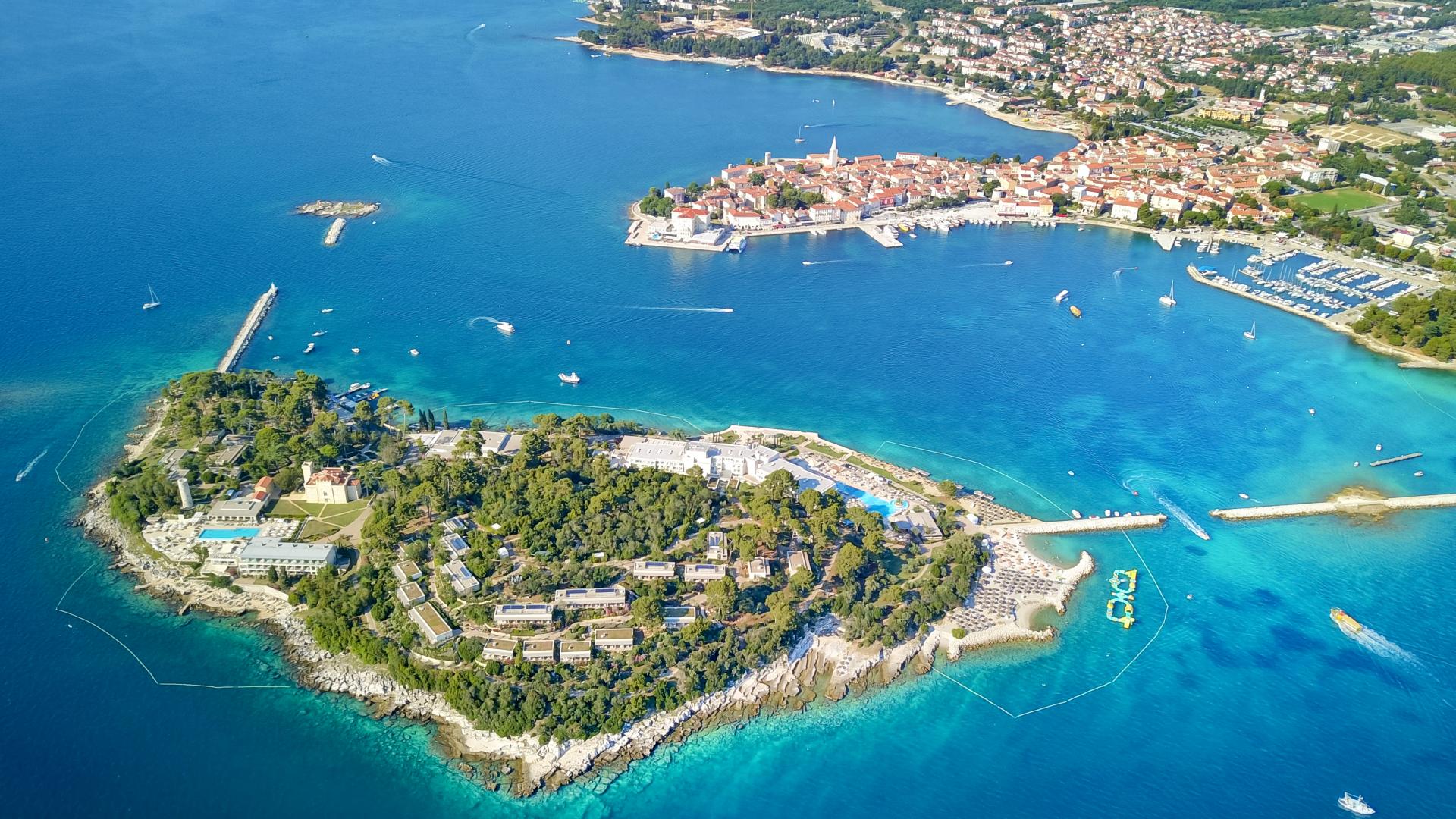
The island of Saint Nicholas in Poreč and Isabella Castle, Valamar Isabella Island Resort / Poreč Tourist Board
I recommend visiting this lovely island across Poreč at least once during your stay to enjoy beautiful, clean, and tidy beaches. It has always been a kind of undiscovered place for my family and me, even before it was renovated by Valamar, the biggest tourism company in Croatia. A nice walk around the island to experience nature's calmness and see the old but now renovated Isabella castle is a must!
On the island and in the whole city, a lot of effort has been put into facilities and activities for children. Along the beaches, you can find numerous children's playgrounds and toboggans. Poreč invests a lot in education, which I witnessed last year when I found out they even have summer tourism workshops for children. Also, children's camps are organized on the beaches, where you can often see many animators with groups of children. There is also a diving school on Brulo Beach.
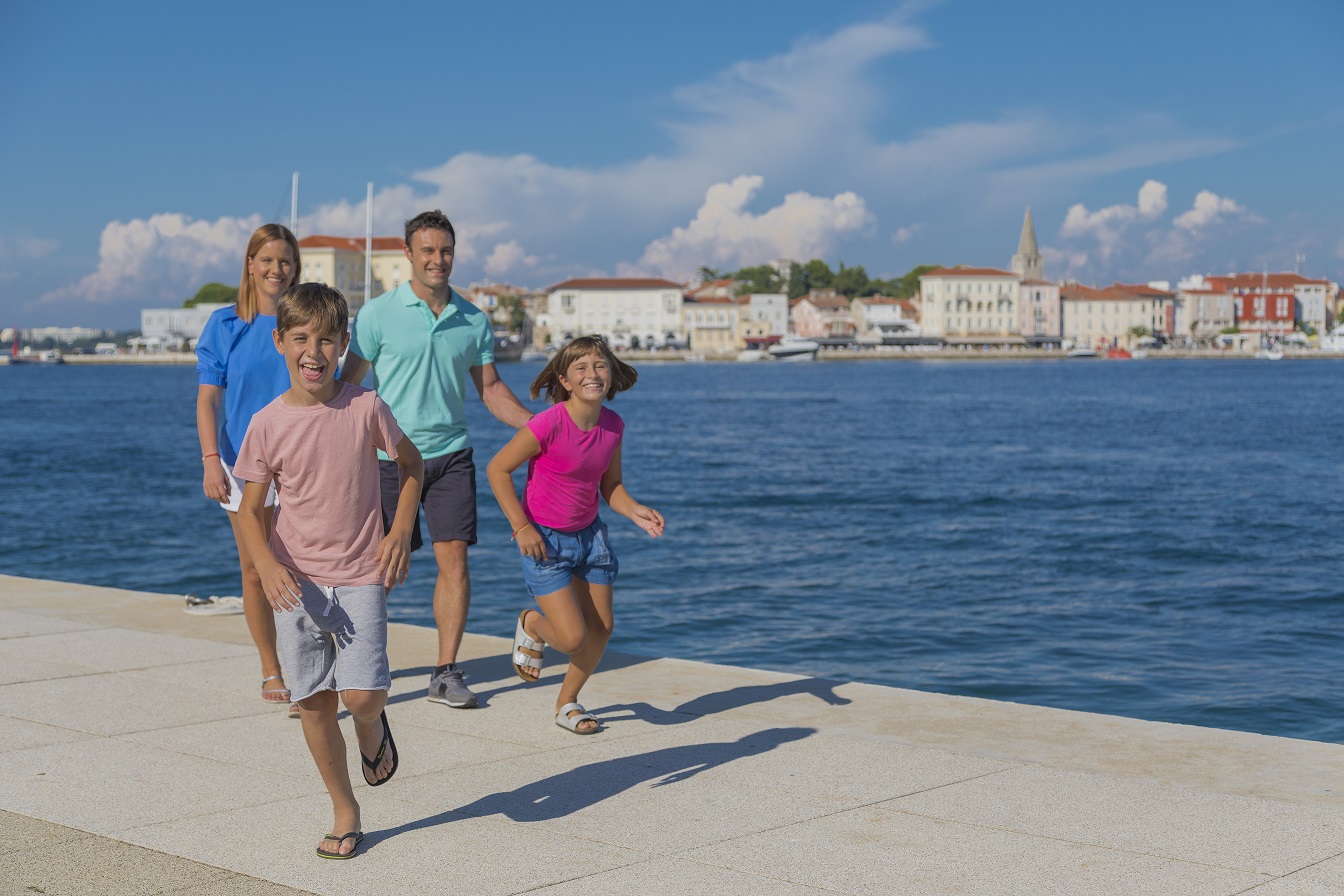
Poreč Tourist Board
Is Porec in Croatia worth visiting for daily boat excursions?
Daily boat excursions from Poreč to surrounding bays and cities are among the most popular activities among tourists. While walking along the waterfront during the evening, when many tourist boats are waiting for their next venture, you can book one-day boat trips to Rovinj, Vrsar, and Lim Fjord, fish picnic trips, and submarine ride. You can also find boats and taxi boats to the nearby Poreč bays, such as Green Lagoon, Blue Lagoon, and White Bay.
One of my earliest travel memories was a one-day trip to Venice from Poreč when I was eight, which I totally recommend. Even though I have seasickness, my first trip to Italy was by boat from Poreč, and I absolutely loved it. Hopping to another country and another city in the middle of your holidays was so exciting back then, and I hope that soon the circumstances will allow the like journeys again.
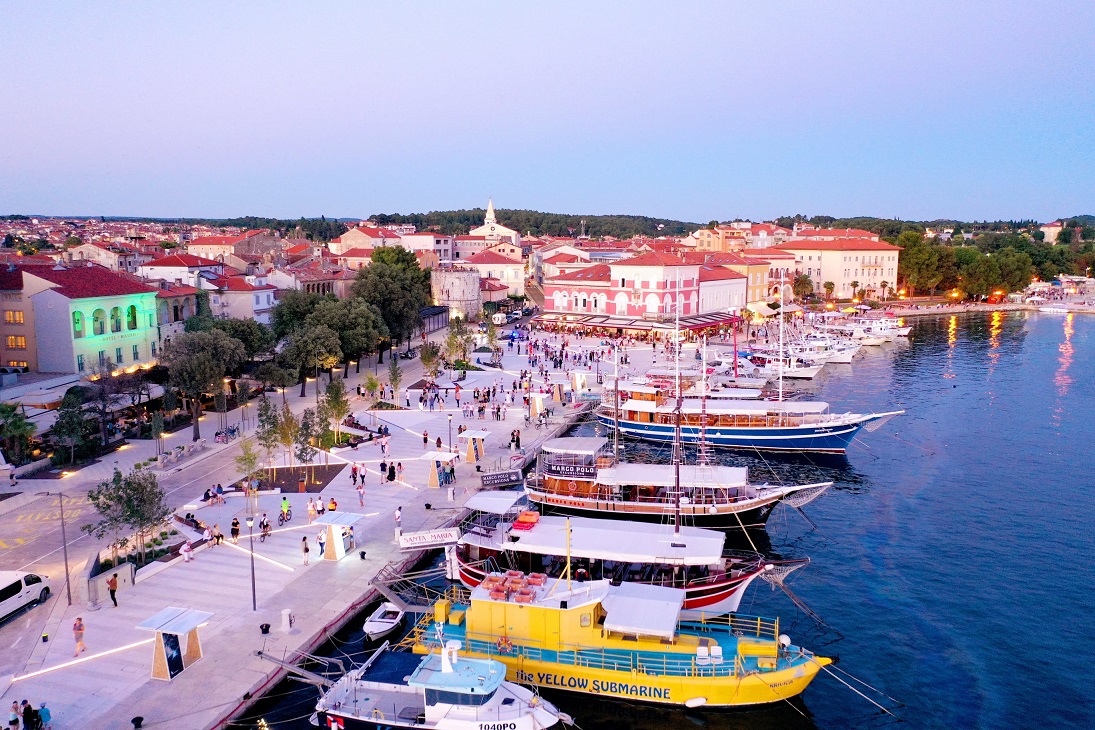
Tourist boats in the Poreč waterfront / Poreč Tourist Board
Is Porec in Croatia worth visiting for nightlife?
Here comes the fun part. During the summer evenings, at the beginning of the city waterfront, you will not be able to miss the sounds of the world's greatest hits and dance rhythms from the famous Poreč club Saint & Sinner.
There is no shortage of night bars and clubs in the city, and the Poreč casino is also popular. Various performers (most often musicians) perform at the summer terraces of hotels and restaurants almost every day. One of the most famous such summer bars is the Lapidarium.

Saint & Sinner / Poreč Tourist Board
At the very top of the Poreč peninsula, at the foot of the Riviera Hotel, music from the attractive Palazzo Club attracts attention. Besides, there are numerous lounge and beach bars by the sea.
I also remember seeing organized transport vehicles around Poreč offering transport services for party people to the nearby famous nightclub Byblos. I'm sure I'm not the only one who is nostalgic about crazy summer parties! Last summer, it was relatively quiet in Poreč, but let's hope for the better in the upcoming summer season.
As for parties, Poreč is also known for hosting Poreč Open Air Festival, an all-summer-long festival that consists of street performances, music nights, cinema, theatre, and special events. The MTV Summerblast in Poreč was also held, but due to the current situation with the coronavirus, the holding of all festivals is uncertain for now.
Is Porec in Croatia worth visiting for gastronomy, adventure, and education?
Although the temperatures in Poreč are high and the sea is warm, I will not lie - almost every year, I experience one rainy day during holidays. However, such days allow me to explore Poreč and its surroundings.
In addition to the many hotels and apartments, many famous restaurants and cafes in Poreč offer only the best Istrian delicacies. Getting to know the local specialties is an indispensable part of getting to know the destination. In Poreč and Istria, those are, among others, truffles, olive oil, Istrian prosciutto, Istrian boškarin beef, asparagus, and seafood, offered in best of Poreč offer. Along the Dekumanova Street in the old city core, you can find many patisseries with ice cream.
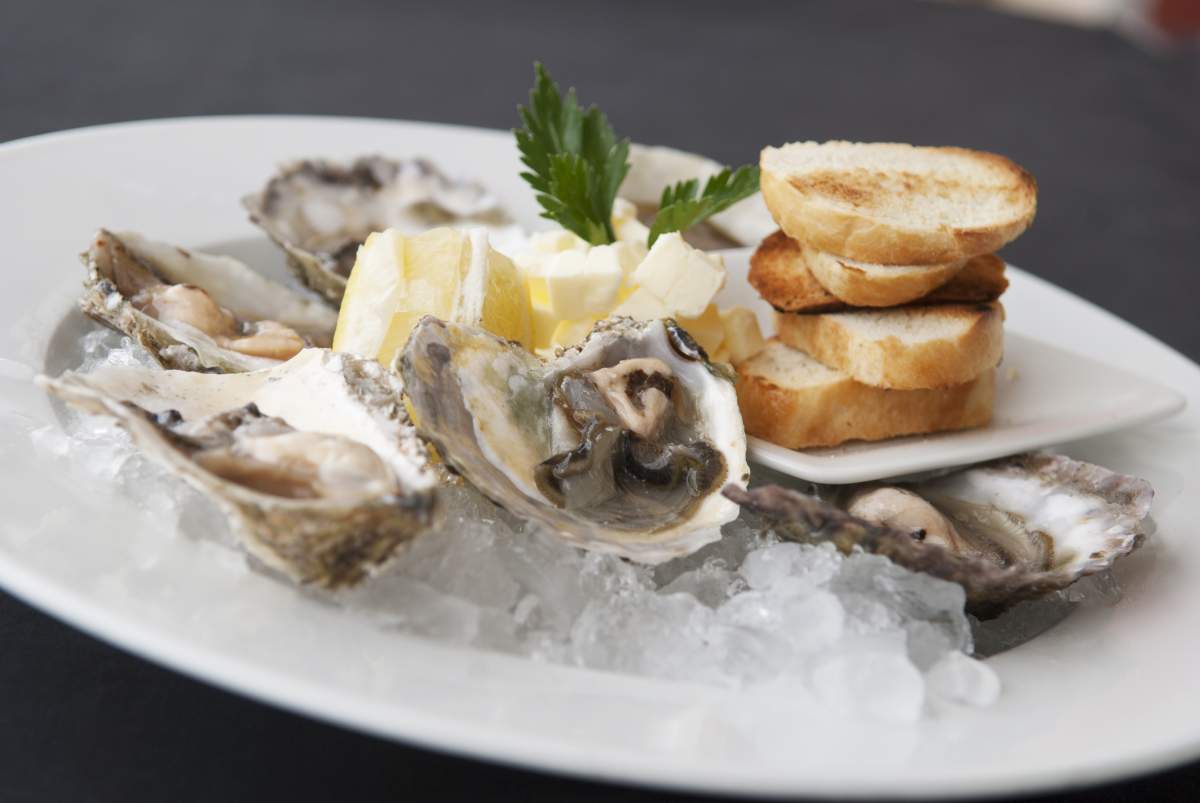
Istrian food - scallops, mussels, oysters / Poreč Tourist Board
I don't have to emphasize the importance and popularity of Istrian wines and wine roads. One must taste them when in Poreč, but what surprised me last year was the favorite activity of Istria people – truffle hunting. It was the best activity for me in the whole visit to Poreč and Istria the previous year, and it is worth experiencing!

As part of a truffle hunting tour, we ate an Istrian specialty - scrumbled eggs with black truffles / Donatella Pauković
And since Istria has been named the best olive oil region in the world for the sixth consecutive year, my next visit will for sure include olive oil roads in the Poreč hinterland.
Near Poreč, there are many entertainment and educational facilities, such as Motodrom Poreč with karting. In addition to karting, many other activities are offered: bigfoot riding, cross-kart driving, segway, quads motor wheels, paintball, and Adventure Park SkyFox. It is possible to ride horses in the nearby horseriding centers in Poreč.
Motodrom Poreč / Donatella Pauković
A few years ago, we spent a day visiting the Baredine Cave, at the bottom of which we saw one of the few specimens of a human fish. I recommend the Baredine Cave if you get bored of the heat because by descending to a depth of 60 meters, the air temperature also drops to 14 degrees Celsius, which is a shock compared to the outside 30 degrees during the summer days.
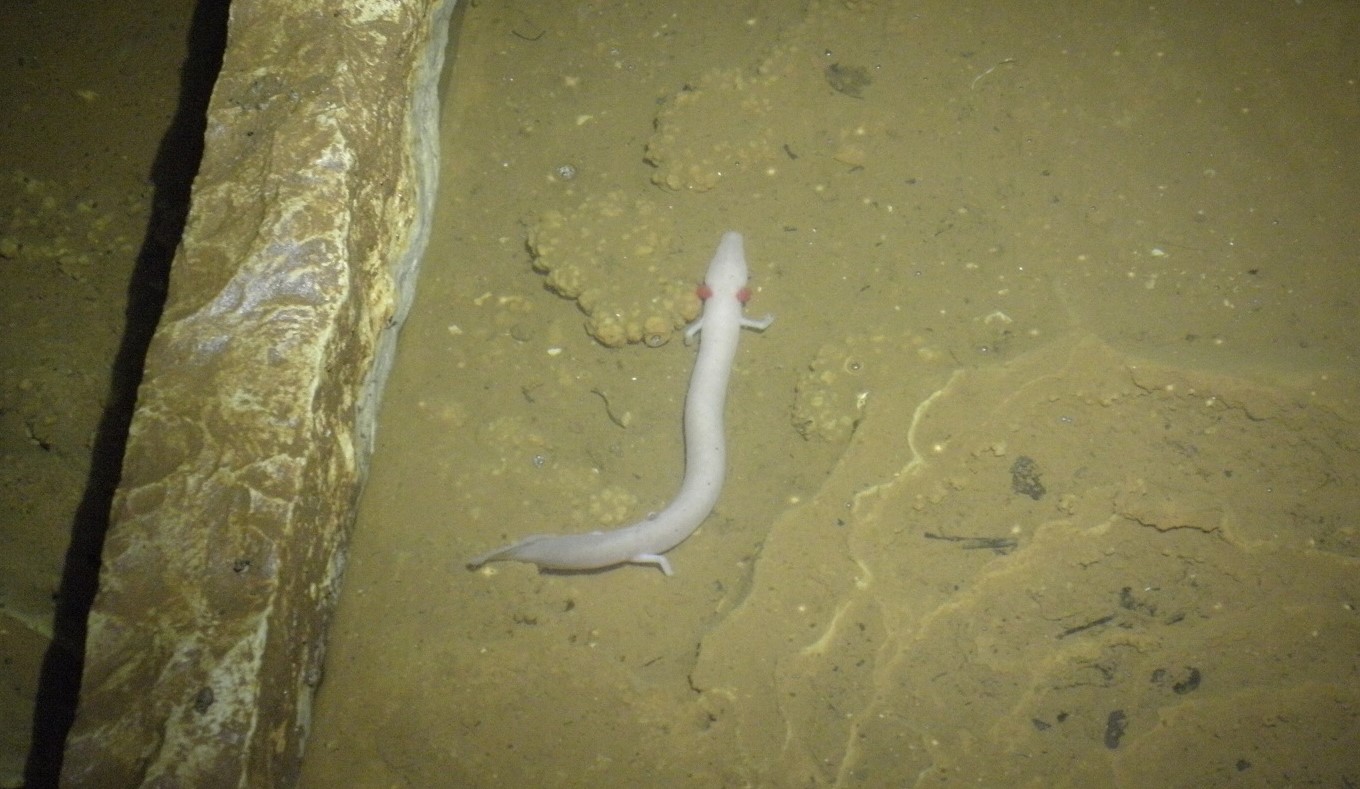
Human fish in the Baredine Cave near Poreč, Istria / Donatella Pauković
If you want to get the best from water experience, near the tourist resort Zelena Laguna in Poreč, you can enjoy the largest Croatian water amusement park – Aquacolors Poreč. Also, the attractive Aquapark Istralandia, recently named fourth best water park in the world, is only a 20-minute drive from Poreč.
If you want to learn something about astronomy, the Višnjan Observatory, one of the 12 most productive observatories in the world of all time, is 16 kilometers away from Poreč. During 2018 and 2019, the Observatory discovered and documented over 1,400 asteroids, and recently, as part of a crowdfunding campaign, they secured funding for further investment in scientific and educational facilities.
Conclusion: Is Porec in Croatia worth visiting?
Suppose you want to have active holidays, then yes. In that case, Poreč is worth visiting because it offers a combination of lovely beaches, city sights, beautiful sunsets, rich culture, numerous sports and adventure activities, great food, and even a great nightlife. Poreč simply has it all.
I have visited Poreč countless times in winter when it turns into a quiet town without tourists, and I would always rejoice to see some pizzerias, restaurants, and cafes open even during the winter. Poreč is also a host to many sports teams during winter, who do the preparations for sports competitions in six Poreč sports halls. Did you know that Poreč will soon even have a football camp? It is the result of a long-term investment in sports in Poreč.

Poreč Tourist Board
It is fascinating to me how every Croatian city and place hides many interesting facts, and sometimes it is challenging to discover them all in one visit. Therefore, I know there is a lot more to do and see in Poreč, and I can't wait to revisit it.
Although I have traveled a large part of the Croatian coast in my 24 years and the mainland, I think there is always something new to explore in Croatia, and I'm looking forward to finding out more about my beautiful country in the future.
To follow the People Also Ask Google about Croatia series, click here.
EU Project Living Streets To Turn Streets of Poreč into Living Rooms
September 22, 2020 – Following the example of a similar project that Vienna is implementing with its citizens, a new EU project – Living Streets – will come to life in Poreč this September. It is a project of revitalizing the streets of European cities, turning them into "living rooms". Poreč, along with the Croatian city of Križevci, was granted 20,000 euro for its implementation.
The City of Poreč applied for this project in cooperation with the city company Parentium d.o.o. and the Zone Association (Udruga Zona) for improving the quality of life, as part of the EU project EUKI (European Climate Initiative) Living Streets.
The competition was conducted in Croatia by the Terra Hub association, and Poreč won with a maximum of 73 points for its city "living room" project.
"The project aims, in cooperation with citizens, with systematically and long-term micro-transformations of city streets and spaces that are often congested with traffic and cars, especially during the summer months, to point out the importance of public space in urban areas," says Gordana Lalić, the director of the city company Parentioum d.o.o.
'Living rooms' of cities
One of the project infrastructure solutions will be the installation of the so-called parquets ("parklets"), pavement extensions that provide the tenants of nearby buildings with more space and possibilities for rest and socializing.
"We are witnessing that city street and squares are much more than transit areas. They are primarily spaces that can and must enrich the community – socially, and economically. To achieve this, it is necessary to 'activate' the streets, facilitate access for pedestrians and cyclists, and implement programs that encourage the participatory action of our citizens," explains Ajna Temimović from the City of Poreč.
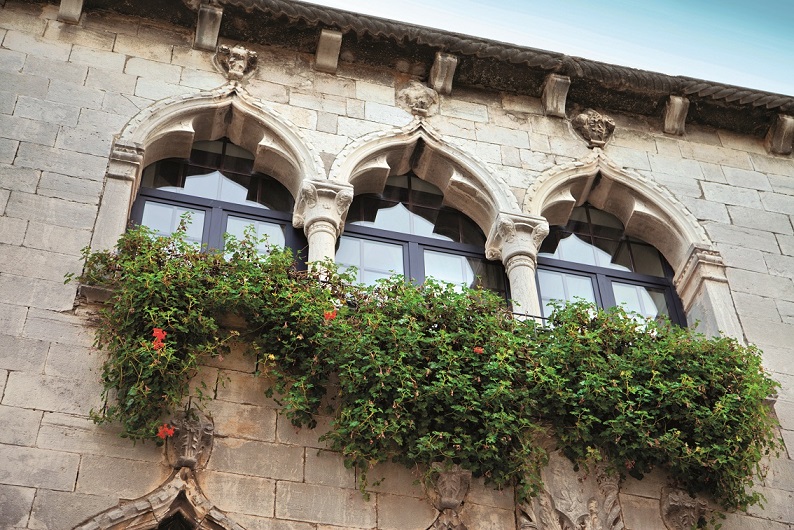
A detail of trifora windows on the Ghotic Palace in Poreč / The City of Poreč
"By creating space for people, inviting them to socialize, that is, presenting a public space accessible to everyone, urban city spaces are enriched, and their original purpose, which is to serve the citizens, is returned to them," adds Temimović.
The parquet concept will be built on the model of the Austrian capital Vienna, where, according to the same principle, about thirty locations have already been turned into pleasant meeting places and good neighborly relations.
This year, thanks to many projects, Vienna took the title of the best city in the world in terms of quality of life for the ninth time in a row. Their project CityMaking! Wien, among other projects, encourages citizens to arrange their small oases to relax and socialize in front of the buildings in which they live.
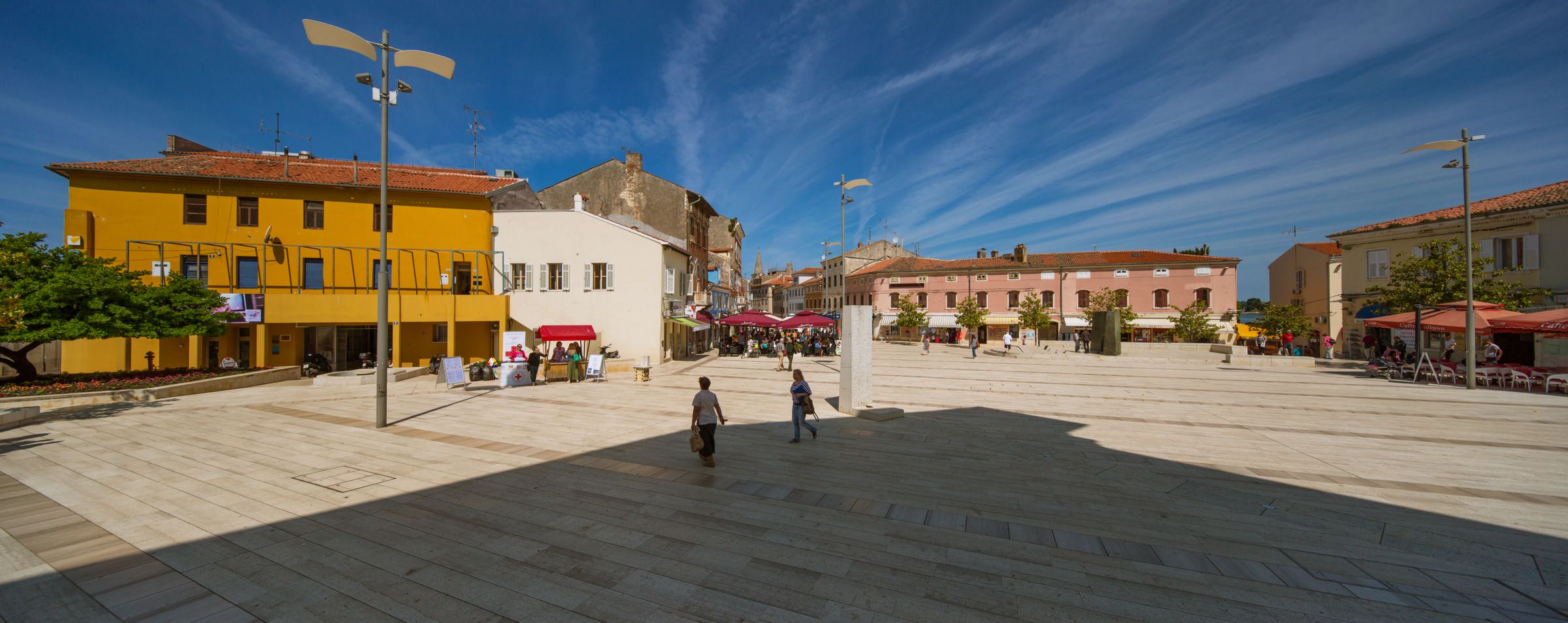
Freedom Square (Trg slobode), the main square in Poreč / The City of Poreč
The importance of climate change mitigation
Poreč therefore successfully follows the Viennese example of revitalizing urban spaces, while the Croatian capital attempts by citizens to bring a breath of life to the streets during these difficult times are banned and even punished for absurd laws, as we witnessed when two Zagreb citizens planted a small garden in front your building during the lockdown.
"Cities have a key role to play in climate change mitigation and adaptation processes, and all new projects involving urban development must be guided by this," Lalić points out, adding that the planned duration of the Living Streets project is 12 months and it will be implemented from September 2020 to September 2021.
In the Poreč area, the transport sector is responsible for more than half of the total CO2 emissions, or 58.87 percent.
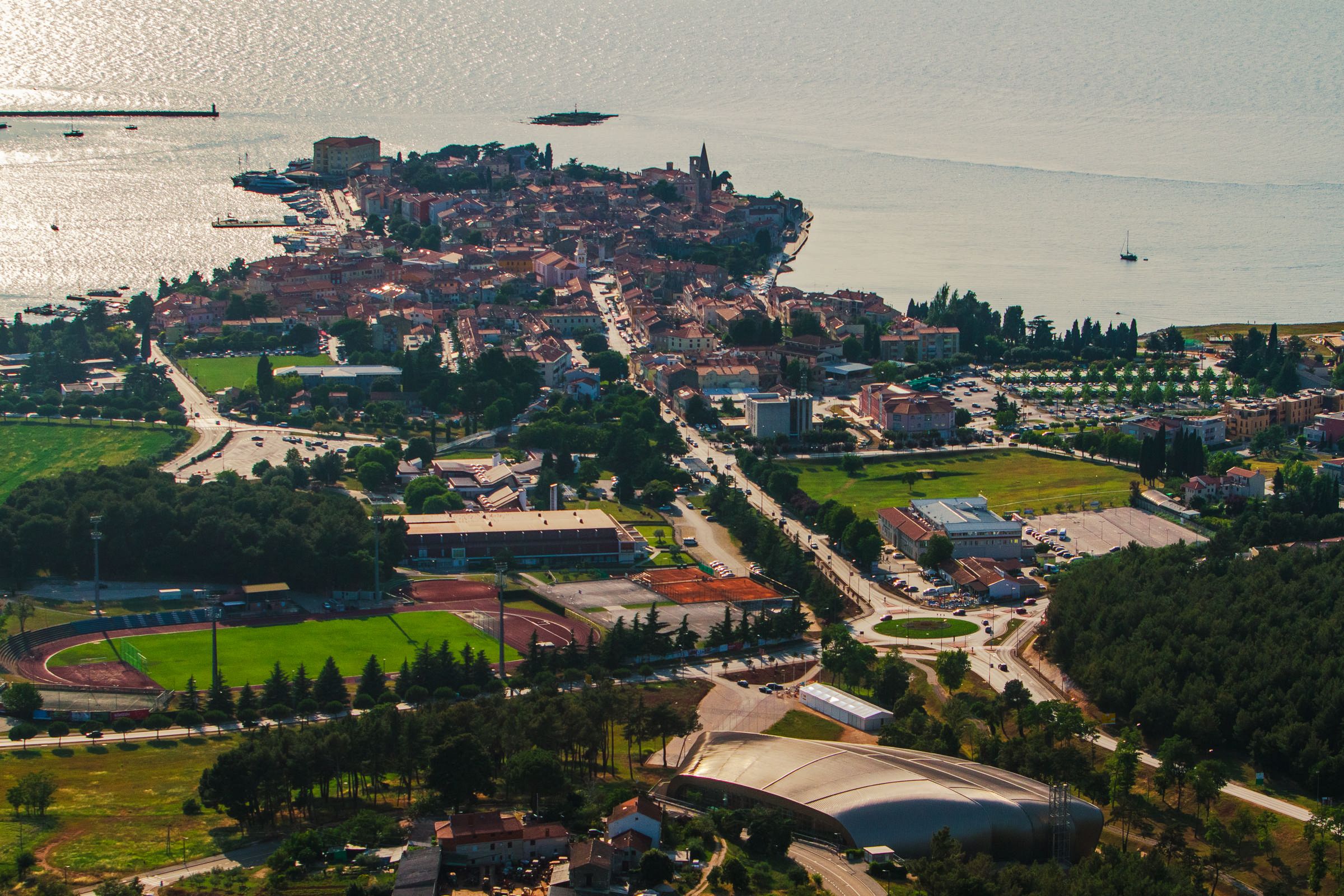
Poreč from above / The City of Poreč
"Sustainable mobility thus becomes one of the key topics of sustainable policies, i.e., one of the preconditions for further sustainable development of the city, and ensuring the highest possible level of quality of life for the citizens of Poreč," says Temimović.
In addition to parquets, a series of workshops, actions, and public events are planned, all to „encourage the reduction of the use of personal vehicles, which will consequently reduce negative impacts on human health, reduce greenhouse gas emissions and improve the quality of life in the town,“ says Lalić.
A great interest of other Croatian cities for the project
However, Poreč is not the only city that can boast the Living Street project. Namely, as many as 21 Croatian cities have applied for projects to transform their streets into a pleasant and safe space for socializing and connecting citizens.
Poreč and Križevci are the winners of the competition with the highest number of points, and the cities that took third to sixth place – Labin, Pazin, Sisak, and Velika Gorica – were placed in the status of "potential cities" for which the Terra Hub Association, in agreement and cooperation with cities, will try to provide additional funding for implementation.
Other green projects in Poreč
As Temimović explains, Poreč has been working intensively on the implementation of "green" projects for a long time.
So far, the city has participated in the national action "Plant a tree – do not be a stump" ("Zasadi drvo – ne budi panj") in which citizens planted more than 500 tree seedlings. They also have as many as seven charging stations for electric cars, and their utility and traffic police use electric vehicles.
According to Temimović, they obtained co-financing for them from the Environmental Protection Fund, and through another EU project, they are in the process of procuring an electric-powered minibus to develop a pilot project for public transport.
The purpose is, of course, that over time, Poreč streets become greener and, above all, more accessible for citizens to socialize.
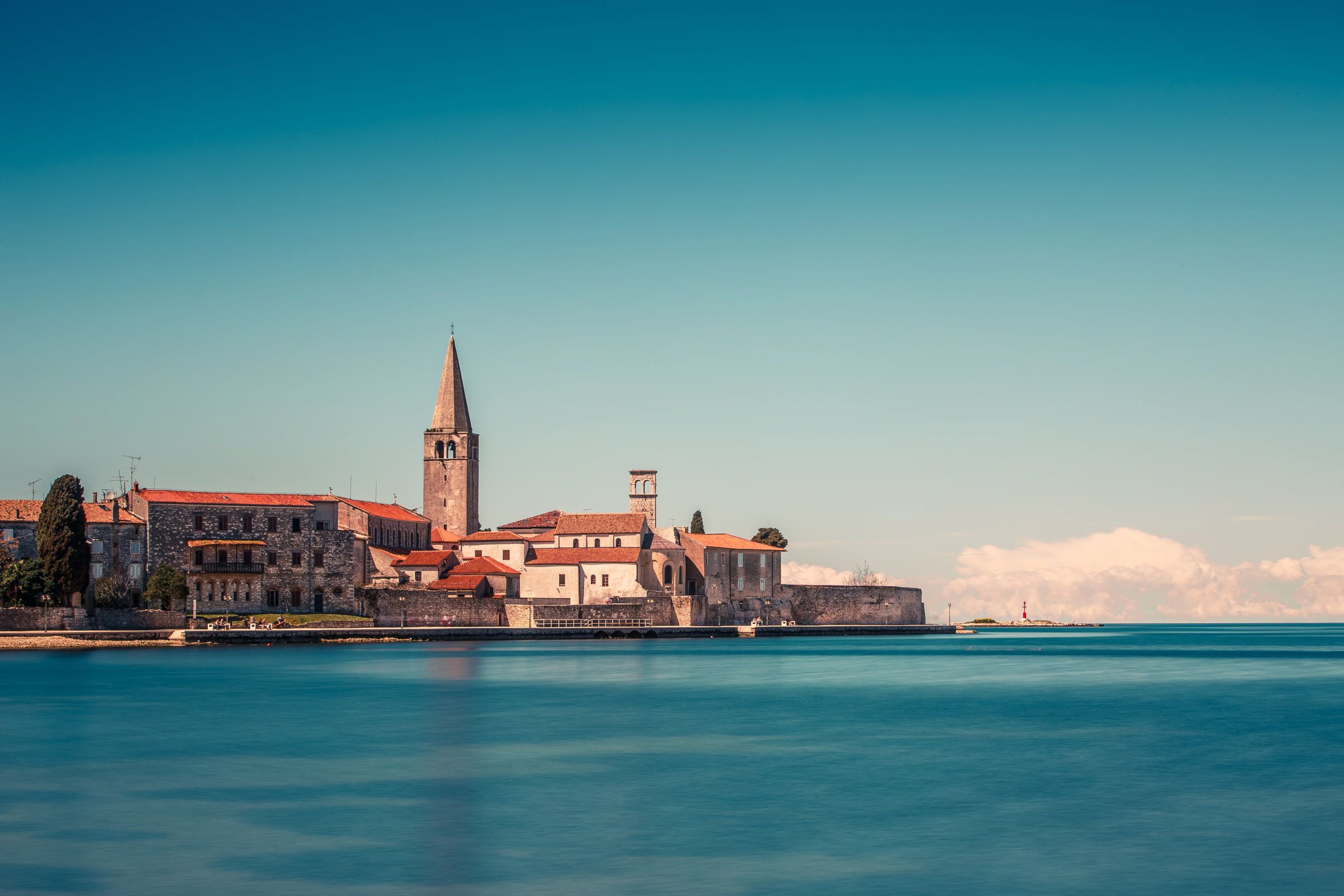
The old town Poreč / The City of Poreč
European Caverescue Association Conference (ECRA) Held in Poreč
As Glas Istre/Andjelo Dagostin writes on the 16th of November, 2019, ninety rescuers from eighteen countries across the world are attending the conference in Poreč, Istria.
The thirteenth conference of the European Caverescue Association (ECRA) opened yesterday near the Baredine cave with ninety rescuers from eighteen countries partaking. The opening was attended by Poreč's Elio Štifanić and the commander of the Poreč public fire department, Denis Matošević. Also present at the conference's opening was the President of the Tar-Vabriga Tourist Board Denis Žužić and host Silvio Legović.
The introductory conference was moderated by the Marko Rakovac of the Croatian Mountain Rescue Service (HGSS).
''I'm convinced that with your suggestions and with the exchange of experiences you will contribute to the development of the rescue service and efficient rescue in humanitarian crises,'' stated Denis Matošević.
The meeting was originally planned in Turkey, but was cancelled due to the unfavourable political situation. The counrtries participating in the event are caving and rescue services from Austria, Bosnia and Herzegovina, Bulgaria, Canada, Croatia, Czech Republic, Germany, Hungary, Italy, Norway, Poland, North Macedonia, Romania, Slovenia, Switzerland, Turkey, the USA and the United Kingdom.
On the first day, an underground rescue workshop was held where international experiences were exhanged in order to help injured persons as quickly, safely and as effectively as possible, both underground and in other humanitarian crises.
Expert workshops will be held at the event, which include caring for the injured, how to properly handle the injured, internet in the underground, carbon dioxide in the underground, rescue missions in submerged speleological facilities, the widening of narrow passages in the underground and certification.
In addition to expert lectures, demonstrations and workshops, an important topic of the roundtable discussion will be the establishment of the World Caverescue Network and a diving exercise near Tar. Otherwise, the ECRA - European Caverescue Association (ECRA) was founded back in 2012 and has its headquarters in Zagreb.
Make sure to follow our dedicated lifestyle page for more.
Poreč Successfully Lowers CO2 Emissions by Four Percent
As Morski writes on the 9th of August, 2019, over the past five years, the City of Poreč has invested almost seven million kuna into more than thirty projects in the fields of energy efficiency, sustainable development, e-mobility and environmental protection, for which as much as 4.2 million has been withdrawn from various funds for national projects and from EU funds.
At the same time, Poreč has recorded nearly 550,000 kWh of produced "green" electricity and heat from solar power plants, as states the data from the city's parent company, Parentium d.o.o., which is in charge of the Poreč's construction and energy efficiency activities.
The success of the implementation of projects in this area, as well as the almost 100 percent realisation of the plan for energy efficiency measures in the area of the City of Poreč in the past five years, was also discussed during the adoption of the document of the revision of the Action Plan for Energy Sustainable Development of the City of Poreč at the penultimate session of the City Council.
''The City of Poreč is the second largest city in Istria County, a city of positive natural growth, a city to which people move, a city of above-average infrastructural equipment and communal development, a city that, in many areas, provides above-standard conditions for all its citizens over the past five years.
During the [aforementioned five year] period, we were able to implement 31 out of the planned 37, and an additional 6, energy efficiency measures in our city, which, despite the fact that the City of Poreč is constantly growing and developing rapidly, managed to achieve an almost 4 percent reduction of total CO2 emissions in the area of our city. Not only that, but by drafting and adopting strategic documents, and in line with the European Energy Policy, we have set new, even more ambitious goals for energy efficiency and sustainable development. In the period until 2030, we plan to reduce our CO2 emissions by 40 percent,'' stated Gordana Lalić, CEO of Parentium, a company that has the role of coordinator in the implementation of these projects in Poreč.
She also added that, bearing in mind the fact that climate change is a cause for grave concern, both globally and locally, and that it has enormous potential for harm to human health, the overall economy, and society as a whole, the powers that be in Poreč are aware that working to achieve CO2 emission reductions alone won't be sufficient.
For this reason, as one of the first six cities in Croatia, the City of Poreč has drafted a Strategy and the accompanying Action Plan on Climate Change Adaptation, one of the basic prerequisites for applying for new projects and withdrawing EU grants, especially in the next programming period - from 2021 to 2027.
As a future direction for the development of Poreč over the next ten years, the plan is to develop the "smart city" concept, in the field of construction, public lighting and transport, as well as in all other segments, with special emphasis on the implementation of measures and projects in the field of climate change mitigation and adaptation, with the aim of ensuring the sustainable development of the city and achieving the goals of the European Energy Policy.
In the already mentioned areas, the City of Poreč is currently implementing 8 projects, an application has been made for 3 more projects, and the results are now being waited on, while at present, the intensive preparation of 4 projects, the application of which is planned for the autumn of this year is ongoing.
Make sure to follow our dedicated lifestyle page for much more. If you're interested in Croatia takes care of the environment, give Total Eco Croatia a follow.
Poreč and Novigrad Lead the Way, More Babies Born and More People Settling
As Novac/Gradonacelnik.hr writes on the 30th of July, 2019, with the increase in babies being born, more and more people are actually moving from elsewhere to Poreč.
"These developments are not and cannot be the result of simple one-off measures. These positive developments are, first and foremost, the result of a stable economic situation. Poreč, besides being the most developed city in Istria, is also one of the most developed in all of Croatia. Although it has only 20,000 inhabitants, Poreč's entrepreneurs have created 1,000 new, year-round jobs over the past four years alone. This is one of the main reasons why many young families choose Poreč as their place of residence. It is up to us, as the city, to ensure quality living conditions for all,'' says Poreč's mayor Loris Peršurić.
He adds that in two years, they have independently built two new elementary schools, so that all children can take classes in one, morning, shift. In addition, they are building a second kindergarten this year due to the increased demand for enrollment and a steady increase in the number of children attending the facilities, and a grant of 85 percent for that from the Ministry of Agriculture has been successfully obtained.
''The city distributes the largest types of scholarships in the country for students, it co-finances supplementary health insurance for all retirees and provides other benefits such as co-financed accommodation in the city's nursing home, provides the best standards in emergency medicine situations, has increased its benefit for first-born babies by 50 percent, and the social program is among those of the highest quality in the entire country,'' said Peršurić, adding that they are currently developing a city model that aims to make it easier for young families to get to their hands on their first property.
Novigrad, just like Poreč, had a negative population growth rate in 2017 in terms of births, but also recorded increased migration.
“We believe that this is, in a large part, the result of our efforts to provide the best possible living conditions for our fellow citizens, especially young families, such as resolving existential housing and employment issues, introducing above-average standards in the pre-school education of children, and generally raising the social and communal standard in our city. There are a number of concrete social and other measures in place to help children, young people and young families, all with the aim of retaining or attracting them from elsewhere to our city,'' says Novigrad's mayor, Anteo Milos.
Some of the projects through which Novigrad encourages a more positive demographic picture are the (co) financing of food and equipment for infants, subsidies for the second child in kindergarten, participation in kindergarten costs, free textbooks, the co-financing of high school transportation costs and subsidised housing projects. In Novigrad this year, there has been a record number of students enrolled in the first grade in primary school, as well as a higher number of younger children in kindergartens.
As cities like Novigrad and Poreč continue to lead the way and set a valuable example to the rest of Croatia, when will the country catch up in terms of learning how to properly retain its population? The Croatian Government's decision to lower VAT in the hospitality sector should bring positive results, but there is far more work than that to be done.
Make sure to follow our dedicated lifestyle page for much more.


